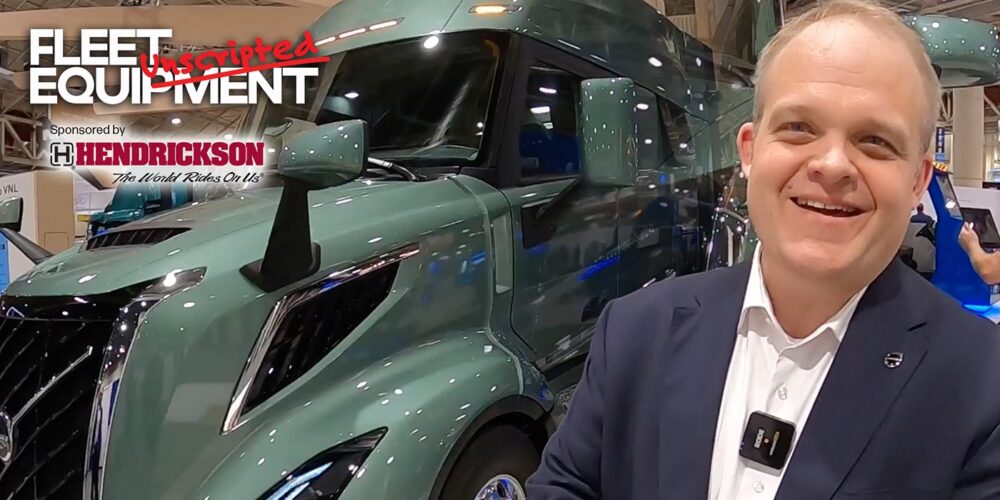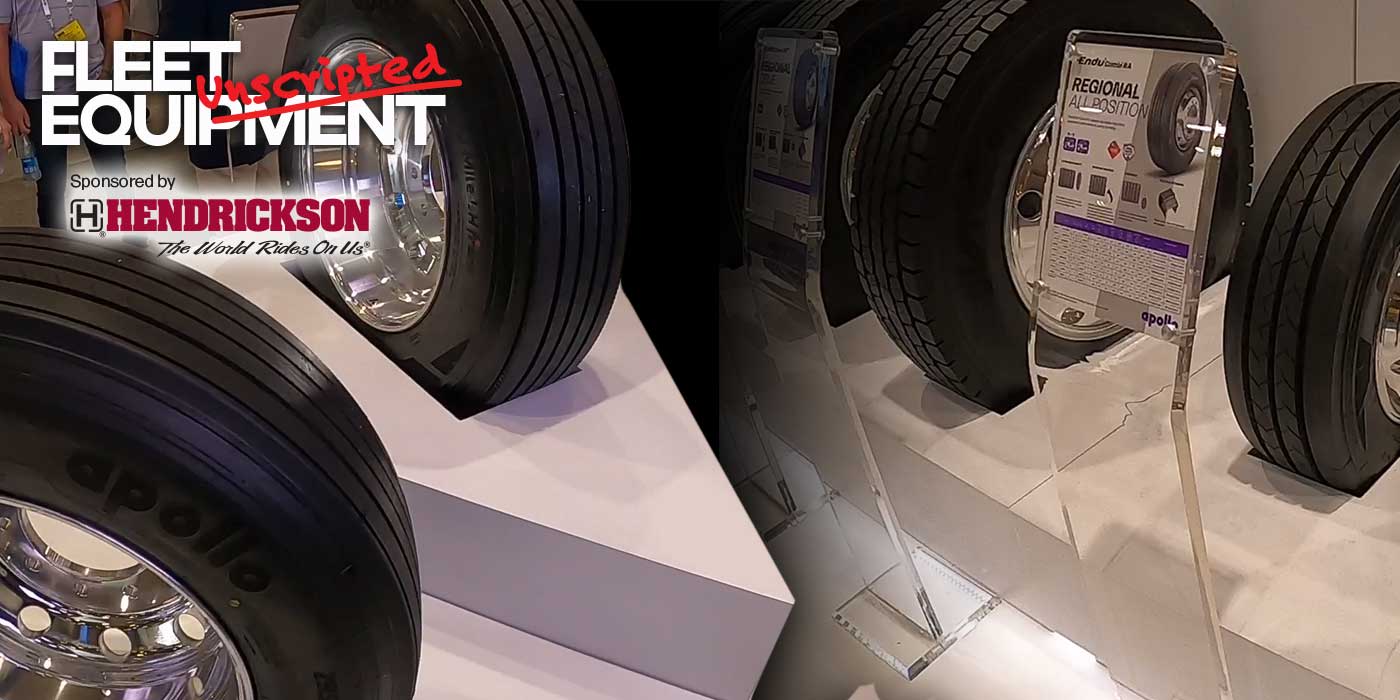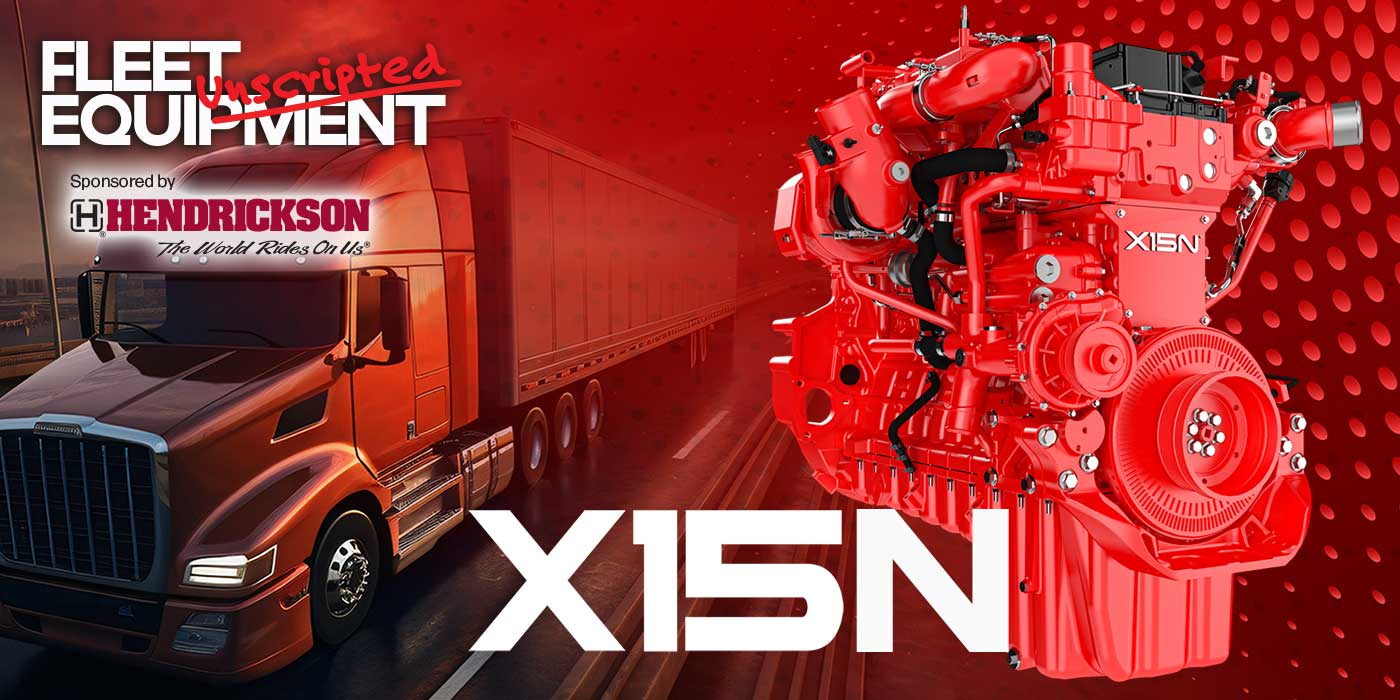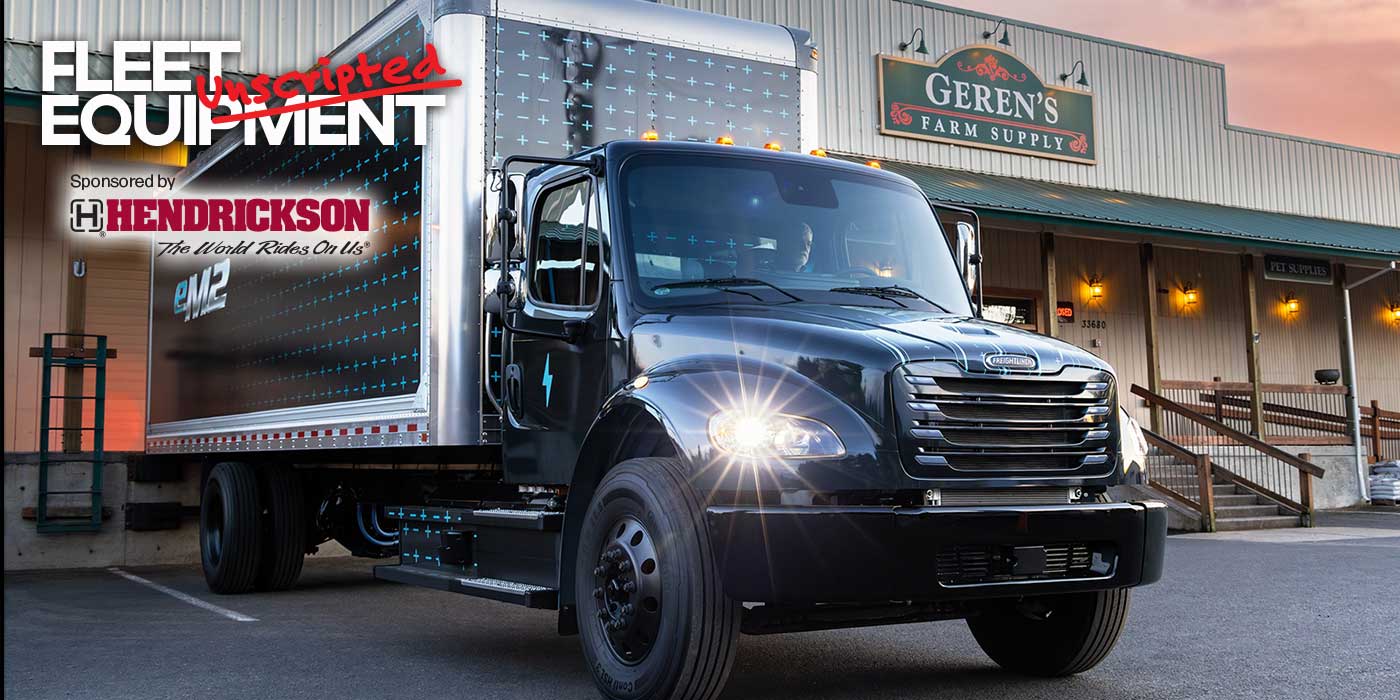Part of the very small upside to the pandemic was the advancements in digital tools, or perhaps more accurately, advancements in the people actually using the digital tools we had at our disposal. Virtual training on both the product knowledge and service side of trucking was available, but the pandemic put its usage into high gear. Hendrickson is a great example of how virtual training has grown. The company has offered service-focused virtual training with its Service Academy since 2017 and extended that knowledge into the product knowledge world with the 2021 launch of Dealer Academy.
The business world, today, is getting back to actually seeing human faces and being in the same room. So what’s the value of virtual training?
Jeff Sass still sees a lot of it in our new hybrid working world. I caught up with Hendrickson’s vice president of marketing and Sass laid out the role virtual training continues to play in the industry. Watch the video above for all of his insight.

No script? No plan? No problem. Welcome to Fleet Equipment Unscripted—the video interview series that connects you with the greatest minds in the heavy-duty trucking world.
Bookmark the Fleet Equipment Unscripted page to catch all of our Unscripted episodes, and subscribe to our newsletter by clicking here to have the latest news and in-depth trucking stories delivered straight to your inbox.
Fleet Equipment Unscripted is sponsored by Hendrickson.
Here’s the transcript
Jason Morgan:
Hi, everyone. I’m Jason Morgan, Content Director for Fleet Equipment and welcome to Fleet Equipment Unscripted. Today we’re talking with Jeff Sass, Vice President of Marketing at Hendrickson. Jeff, thank you so much for connecting.
Jeff Sass:
Oh, thank you for having me. Appreciate it.
Jason Morgan:
We’re going to talk about how training has changed and boy, has it changed over the past … I mean, gosh, I guess we’re two years into this now, two years of how our world has changed and adapted it. And I know over on the Hendrickson’s side, you’ve recently talked about the Dealer Sales Academy.
Jason Morgan:
Can you just give me a quick overview of how you’ve seen training evolve, what role the virtual training is playing, and how you’re using it?
Jeff Sass:
I’m happy to. I even started with blogging before COVID. With the advent of YouTube, people can do home improvements. How to patch a drywall or how to remove a drain in your shower, to how to cook a Chateaubriand. Everything in the world you can find out on YouTube.
And we started in 2017 with our Service Academy. Our service director found a YouTube video that showed how to fix one of our components 100% wrong. And he came to the marketing department and he said, “Hey, we’ve got to nip this in the butt. We got to get good content out the there.” And it was on the Tiremaax program, is what was our first one.
In 2017, we started with the Service Academy, and that was mainly for technicians to give them instruction on how to fix the Hendrickson products. But as you said, the last two years it has just completely ramped up and accelerated. So that service academy, we’ve got about 5,000 users now.
Certain fleets have 100% embraced it. And we’ve had over 7,500 courses finished.
Now we have almost double that are not finished, and that’s because the technician finds the answer or finds the way they need to fix the product, and then they just don’t complete the course. So it’s still serving its purpose, it just, we don’t get a completed course out of it.
But as you said, last year we launched our Sales Academy, for a couple reasons. One, our sales team wasn’t traveling as much to get out and see the dealer sales people, wanted to keep our products top of mind. Two, we’ve had a lot of new product launches.
And we wanted to make sure that we gave everybody out there a chance to understand what the product is, how to sell it, what the tidbits, what the features, advantages and benefits are. So we launched the Sales Academy. And to date, we’ve got nine courses out there.
And we have plans for seven more this year. And our goal is to get 1,000 completed courses by the end of the year. And none of those are Hendrickson people. We filter that out because we all do them just to make sure we know what we’re talking about when we go out there. So we filter out the Hendrickson people, we want to get 1,000 dealer people.
Because if you think about it, across the country there’s probably close to 5,000 truck salesmen and 5,000 trailer salesmen that are talking to customers every day. And if they aren’t talking about our products, they’re talking about someone else’s. We want to remain top of mind with all of the truck and trailer sales people at the dealerships and the distributorships going on.
One other thing is, right now is a great time am to be doing training, because the order boards are full and they’re doing a lot more management of the backlog than actual outselling. We want to make sure that we give them the tools to be able to talk about our product when they have the time, instead of beating the bricks and knocking on doors.
Jason Morgan:
Yeah, for sure. I want to go back though, because I am glad you brought up maybe the misinformation or maybe not accurate information’s out there. Because I have done that as well. I have fixed a mower, but given the black smoke that was pouring out of it, then I’m not sure I fixed it so great. I don’t think this video that I found on YouTube was so wonderful.
When you’re looking at then, from the manufacturing or the supplier side, how do you go about developing those materials and those virtual materials, integrating video verse maybe some of the traditional training materials we’re used to. How do you do that and make sure people are learning the right way?
Jeff Sass:
The process is different on service versus sales, so I’ll start with the service side.
The service side, there are specific steps that need to be taken in a specific order in order to service the product properly. So that is a script that’s written out verbatim on what needs to be done step-by-step to fix the product.
And then we go through and write a script that will be narrated around it. And then we have actual film crew in one of our bays, with the product, with a certified technician, that’s able to then go and do step-by-step to demonstrate the service aspect of the product.
On the sales side, we start with the quiz.
So we start with, what do we want the salesperson to know.
We write out the quiz or the, at least, six or seven key points about the product that we want them to know. And then we put them in an order that makes logical sense to whoever’s writing the script. Then we write a script, then we do the renderings or the filming and we put it all together kind of backwards.
On the service side you start with step one and do a very particular order of how you fix something. And on the sales side you start with the end. What do you want them to know about the product? And then we build the script around it.
Jason Morgan:
Right. Or yeah, and even taking stock and maybe what they already know about the product as well, and how you can fill in those gaps. Where, to your point, yeah, definitely on the service side, you want to be able to go step-by-step-by-step and do the diagnostics there and making sure that they’re doing the process correctly.
It sounds like an excellent resource as well. But we were just talking a little bit ago, we were at the TMC show. It seems that the world is kind of opening up to some degree. People are coming out, we’re seeing people. We’re still doing this, we still call, but we saw real people week and recently too.
How do you see this virtual training and the academies evolving going forward? What role do they play as people might be getting back together, training managers might be getting out there and seeing dealers and customers again. What role do you see this fill and what gaps will it will put in there?
Jeff Sass:
Well, just as you said, people are meeting people and seeing training managers again and all of that, but you can’t touch as many people as this can. We could have 5,000 people watching this all at the same time across the country. Whereas a training manager can only be in one location, and only can really teach a certain number of people.
But individuals learn in different ways. Some like to be in live classroom, some learn with visual, some learn by listening, some by reading.
It’s all different in the way that people learn, so I think it’ll be a combination of all of these. Some people want to read a manual. Some people want to watch a video. Some people want someone to walk them through it step-by-step. We are going to make sure we have all of those available in our portfolio.
We are going to continue to promote the Sales Academy, as well as the Service Academy. We are go going to continue to give different levels of learning and different means of learning. Even our videos, we show demonstration of what’s going on. And then we put up a bullet point so people can actually read the screen, because there are some people who like to read and hear at the same time. We try and make sure we are addressing the way that people learn in the way that we are teaching the courses.
There will always be a place for face-to-face, whether it’s teaching someone about the product, whether it’s demonstrating. You just cannot replace the relationships that you have with a face-to-face meeting. You mentioned TMC. It was really interesting and really heartening to just hear the buzz of the murmur that was going on in the hall as you entered in at Orlando, because those halls have been very quiet the last 18 months.
So having the chance to actually hear people talking, not actual conversations, but just the buzz around the building, was fantastic. And really makes me think that trade shows again will be a very vital part of our marketing tool. But the Sales Academy and the Service Academy will absolutely.
YouTube is not going away and it’s not all just cat videos. YouTube is used for a lot of reasons and people look at all kinds of different content. We want to make sure that we have relative content out there that’s compelling for the service technicians, as well as the sales people.
Jason Morgan:
Right, right. And I mean, even thinking about it, I imagine how it could even change how your trainers go out there in the market, because you have a system platform that is answering a lot of those immediate questions that either the sales side or the service side’s had. I mean, it’s that resource, it’s the repository. I can just go find it on my own. I don’t need to pick up the phone. I don’t Hendrickson to come out and teach me.
But you probably also see maybe where … You mentioned all the different courses completed and all the different courses taken, but give you an idea of maybe what the pain points out there are. If there are a number of people looking this up or if this is the trend on the service side.
You mentioned how trucks are going to only get older at this point, as we work through supply challenges. And everyone’s churning out as much as they can on the manufacturing side, but we are still hamstrung by some of these supply constraints. So I imagine it might even bring a more targeted approach to how you do the people interaction, you invest the time, invest the people and where to go.
Jeff Sass:
You’re exactly right. There’s nothing will replace face-to-face training. But what these academies do is allow the people to go back and use it as reference. If I was trained three months ago, I may forgotten what step four is in repairing a Haulmaax suspension. So I’m able to go back to the video. I’m able to go back to the course and look at the steps, and remember what I was taught if I hadn’t seen one for a few months.
Same thing on the sales side. I can sit and talk with a sales meeting at a dealership, really walk them through the product that they understand all of it. But if they don’t remember that we offer a site rating of 90,000 pounds on a Primaax EX, that’s something that they can go check out. And they have a very … At their fingertips, they’ve got a video and our sales academy videos are quick. It’s no more than 15 minutes. It gives you all of the information that you need to have the features, advantages, and benefits of the product.
We’re proud of what our format is. We’re proud of the adoption. And the feedback from the participants has been fantastic. They’re really saying that it’s something that’s helpful. They’re saying it’s something that’s efficient. And sales people don’t have the longest attention spans in the world, and they’re saying that they’re actually getting what they need out of it in a quick-paced opportunity.
Jason Morgan:
That’s the battle all across the content world, I will say for sure. And speaking of which, I appreciate you connecting virtually with me. I’ve learned a lot. You’ve taught me a lot here, so I feel like I just want to underwent some training so that’s excellent. I’m sure I will be talking to you again very soon.
Jeff Sass:
Absolutely. We’ll do it anytime you want.













